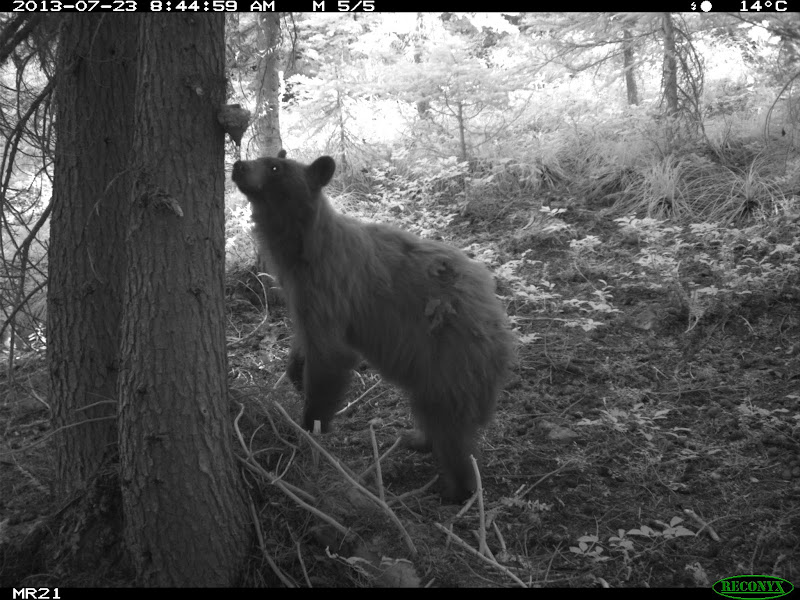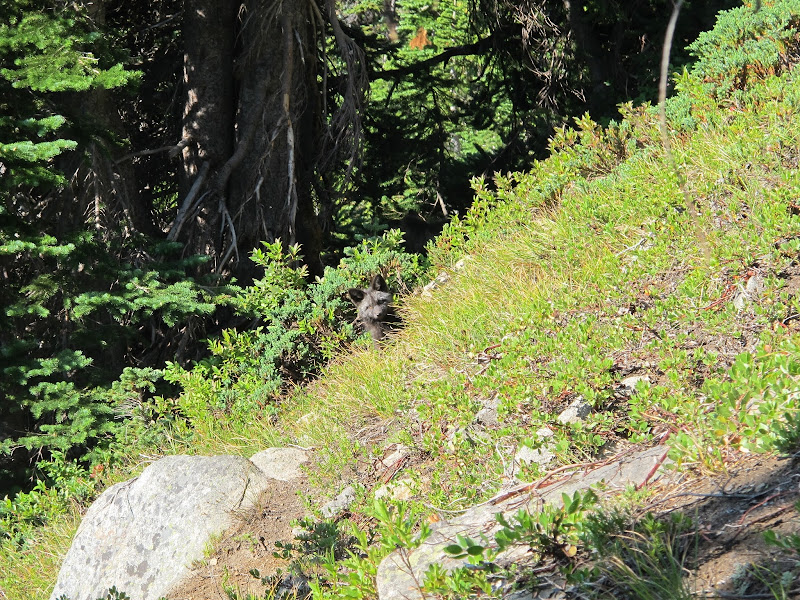Welcome to Harts Pass: a comic strip about life (and wildlife) in Washington's North Cascades!
So describes Erik Brooks, the author of this 3 years and running comic strip from the Methow Valley News of Winthrop, Washington.
This is too cool! Here is a comic strip (and storybook to come) all about one of our favorite carnivores and his critter cohort. Help support the kickstarter project here....three weeks to go!
9.21.2013
Young Cascade red fox in the Goat Rocks Wilderness
This juvenile, black Cascade red fox (also called a silver fox) was detected at a camera station in the southern Goat Rocks Wilderness. Our crews have been surveying a large area of the mountains in southern Washington since late June. We began our summer field season with 6 field biologists setting remote cameras and searching trails they were hiking for mountain fox, wolverine, and coyote scats in the Dark Divide Roadless Area, Goat Rocks, and William O Douglas Wilderness. From these locations, we expanded north, adding 4 crew members, to survey the Alpine Lakes Wilderness and then south to the Indian Heaven Wilderness and Mt Adams.
The Cascade red fox, one of the three subspecies of mountain red fox, is much more likely to produce black and cross phase individuals than the more common red phase typically observed in lowlands red foxes. It is unclear why this occurs but some hypotheses include the red coat color being selected for in the lowlands, perhaps for mating reasons, or the genes that code for red coat color hitch hiking with another gene that is beneficial in the lowlands. The assumption here is that in the mountains, this gene is not as important so all the different variants of the genes occur in approximately equal proportions - each more being equally useful (or useless). Very little research has been conducted on the mountain fox. Any investigation of the differences between mountain and lowland red foxes would be quite interesting and useful to improve our understanding of the conservation requirements of these unique mountain creatures.
9.06.2013
Granite Fire in Alpine Lakes Wilderness
2013 has been a relatively small year for forest fires in the Northwest. That being said, two fires are currently raging in our study area - the Granite Fire in the Alpine Lakes Wilderness and the Conrad Lake fire on the east side of the Goat Rocks Wilderness. This latter fire is not affecting our camera stations though it is blocking access to some of the trails we search for scats, however one of our camera stations is located in the heart of the Granite Fire and I think it may have burned down. Once the area closures are lifted, we will visit the site and let you know what we see. The photograph above shows Klonaqua lakes with the fire burning downslope.
9.05.2013
Den on Mt Rainier
This has been a busy field season and this is a long overdue posting. We have a fabulous group of wildlife biologists working extremely hard on the project and they have been walking trails and setting cameras to collect scat, hair, and photographic detections of Cascade red foxes and wolverines from the Indian Heaven all the way to the Alpine Lakes Wilderness.
Recently, following up on reports from the park service of a mother Cascade red fox and her pup spending time on the north side of Mt Rainier, one of our team, Sean O'Donovan was able to visit the area and locate the den site. He spent many hours observing the foxes and took the photos above. YOu can see that the female is a cross-phase fox and the pup is a black, also called silver, phase fox. From his and an additional visit, we were able to collect quite a few scat and hair samples, which will be sequenced and genotyped in the lab later on to see if there are any additional pups and hopefully who the father is. These data will also help to determine if foxes on Mt Rainier are connected to other populations, such as those in the William O Douglas or Goat Rocks Wildernesses. Look for more information next spring...
4.04.2013
Sunrise, Mt. Rainier
We headed to the White River on the north side of Mt. Rainier to track foxes in the last days of winter here in the Northwest. The weather was fantastic, which was not ideal for tracking. However some fresh snow had fallen a few days before we arrived so we were able to track at Sunrise. This is one of the park's villages at 6300 ft. It is snowed in at the moment and access is via a 2.5 mile trail or 10 mile road. The road will open sometime in July. We headed up the trail, following the boot pack of NPS rangers and collected a fox scat they had seen the day before. Up at Sunrise, there were quite a few fox tracks and we were able to collect scat. I look forward to returning for a much longer visit as this is prime fox habitat and excellent terrain for tracking.
2.23.2013
Coyotes!
We have been working at lower elevations on Mt. Adams this winter to clarify the lower elevational limit of montane red foxes in the Cascades. As a result, we are surveying the habitat of some new carnivores such as the wily coyote. Interesting, we have captured pairs of coyotes as several stations as this must be the breeding season.






Cascade Creek burn
Interesting photos taken from a camera station set on the edge of the Cascade Creek burn, a fire this summer on the south side of Mt. Adams.
2.22.2013
2013 Winter Field Surveys begin
The 2013 winter field season has begun with 8 camera stations set on the south side of Mt Adams in January. Our tasks are to survey along the known lower elevational limit of montane red foxes to clarify their habitat constraints. Second, we are snow tracking the Cascade red fox in an area where several individuals have been detected over the past 5 years. And finally, we are seeking to collect genetic samples from the wolverine in know areas of use.
A good, clear bobcat photo.
First Cascade red fox detection of 2013.
Subscribe to:
Comments (Atom)















